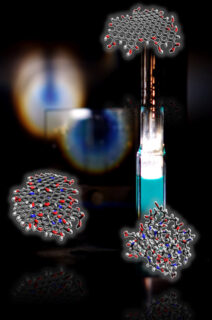Optical processes in carbon nanocolloids
Life on Earth is regulated by light. It is the primary energy source of the planet, it allows some species to see, and it also plays the main role in a wide variety of technological applications. In this context, functional nanomaterials that allow to tailor light-matter interactions will probably be a part of our daily life. Carbon-made nanomaterials lie at the core of a sustainable development of human life, avoiding, for example, toxic waste generation or potential raw material exhaustion inherent to metal-containing nanomaterials.
In particular, carbon nanocolloids (CNCs) have attracted a mounting interest as readily available, non-toxic, and tailorable carbon-based nanomaterials with outstanding optical properties, mainly their photoluminescence. They encompass a variety of carbon particles that have typical dimensions below and around 10 nanometers. CNCs are very heterogeneous materials, and the way of CNCs to technological, environmental and biomedical applications is hindered by the lack of a unifying picture describing the excited states properties of these nanocolloids.
Now, a team of experts from the four continents, including the Chair of Physical Chemistry I of FAU, have jointly proposed to reverse the approach to understand the optical properties of CNCs. Instead of pursuing reconciliation of all the available evidence under the framework of a prevalent model, this team suggests to embrace the complexities of CNCs. Their synergistic efforts were rounded in an article that appears in the latest issue of the renowned scientific journal “Chem”.*
CNCs comprise graphene quantum dots, carbon quantum dots, carbon nanodots and carbonized polymer dots. The fluorescence of CNCs is likely their most attractive optical feature, marking a strong difference with the common carbon-based nanomaterials, such as carbon nanotubes and microscale platelets of graphene and graphene oxide. Specifically, most CNCs display an excitation-dependent emission accompanied by large Stokes shifts that are uncommon features among typical organic dyes. The physicochemical origins of their optical properties remain, however, a source of dispute.
An international collaboration around Prof. Dr. Dirk M. Guldi and Dr. Alejandro Cadranel (Chair of Physical Chemistry at FAU), Prof. Nicholas A. Kotov (Michigan), Prof. Andrey L. Rogach (Hong Kong), Dr. Giulio Ragazzon and Prof. Maurizio Prato (Trieste and San Sebastian) among others, revised key state-of-the-art contributions, which allowed them to identify the fundamental problems associated with the photophysics and photochemistry of CNCs, and to highlight multiple directions of current and future research of this exciting class of nanomaterials.
The elephant in the room is the structure of CNCs, and structure heterogeneity even within the same sample is pointed as the origin of the diverse outcomes following optical perturbations. Additionally, photoinduced energy and electron transfer processes strongly depend on electron donor-acceptor interactions promoted by structural features on CNCs’ surface. The researchers believe that there are specific opportunities to make significative contributions, including shifting and enhancing the absorbance into the red and NIR regions of the solar spectrum, achieving circularly polarized luminescence, facilitating phosphorescence in solution, engineering delicate excited-state processes such as singlet fission, or supporting multi-electron processes, and that these aspects will pave the way of CNCs into technology.
* DOI: https://doi.org/10.1016/j.chempr.2020.11.012
Contact:
Prof. Dr. Dirk Guldi
Department of Chemistry and Pharmacy
Chair of Physical Chemistry I
- Phone number: +49913185-27340
- Email: dirk.guldi@fau.de

